Tiger Woods – Can He Compete at the Highest Level Again?
23rd February, 2024.
The golf world needs Tiger Woods. Without him at a PGA Tour event, everything fades into a blur of fit, grip-it-and-rip-it young men who probably do not bother to delve into golf knowledge to the extent Tiger did and probably still does.
At the 2024 Genesis Invitational, it was utterly amazing to note how the driving range filled up with the who’s who of CBS announcers – Frank Nobilo, Ian Baker-Finch, Trevor Immelman, Colt Knost and others – and then emptied out immediately after Tiger left!
The question on everyone’s mind is – can Tiger be the G.O.A.T again, the golfer who dominates the Tour as he once did? The answer, from a scientific perspective, is yes! With a swing that is based on science rather than tradition, and thus is suitable for his now-considerably-injured body.
It is quite amazing how, at the height of his career, when he won practically every event he played in, he changed from one to the next top golf instructor. Four times. All brand-name swing coaches. Why did he do that? Presumably because he found that something was missing, something that might make him even better.
Now, when he is highly restricted in what his body can do, and he should be consulting a golf performance and injury specialist, he has not sought out a scientific golf evaluation, including the very important ANATO-MECHANICAL aspect. Such an evaluation can help him better understand what every golf swing needs and what he can do to create a consistent, less injury-prone motion for himself.
The COMPREHENSIVE GOLF EVALUATION consists of the following menu. Golfers can choose whichever aspects they wish to. While some parts are optional, the main aspects are: a complete athlete history, gait and posture analysis, golf ball striking with a variety of clubs as well as a study of on-course ball striking.

Understanding what the athlete believes is important for his golf swing, and why
One important part of athlete history is to fully comprehend what the athlete believes is important for him/her to achieve in his/her swing, and why. Professional athletes often have deeply-ingrained cognitive biases, so a golfer must be persuaded through evidence to buy-in to the idea of any swing changes.
In the absence of an in-person interview, this video served as a partial insight into Tiger’s ‘swing psyche’ or his thinking on many important topics: ‘Tiger Woods fixes amateur golf swings’ (https://www.youtube.com/watch?v=5obIcxIgvVc ). Tiger’s thoughts on many swing topics as well as research-based proof of what he needs to reconsider are provided here.
Putting together all his tips for the many golfers he made useful suggestions to, one can see that some of the things that matter to Tiger are: a good grip, a neutral shaft and clubface at the top, correction of a strong grip with a slightly ‘cuppy’ wrist to open the face up at the top. Below is his current picture at the top. Do shaft and clubface positions at the top actually determine their positions at impact or is that merely a traditionally preferred concept?
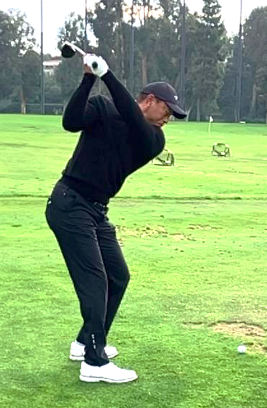
He likes the left arm ‘connected’ (close to the chest) and hands low at takeaway (see first picture below) with the clubhead slightly in front of the hands, never allowing the club to get behind the hands in the takeaway. All to avoid a re-route (see second picture below). How about getting back to a top of backswing position from which one cannot possibly have a re-route (third picture below)?
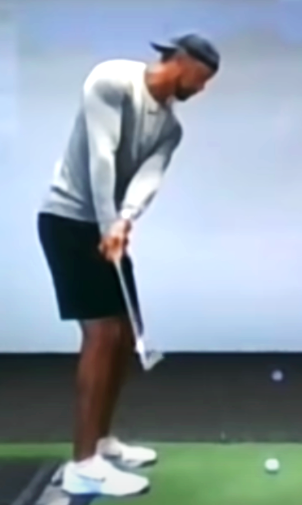
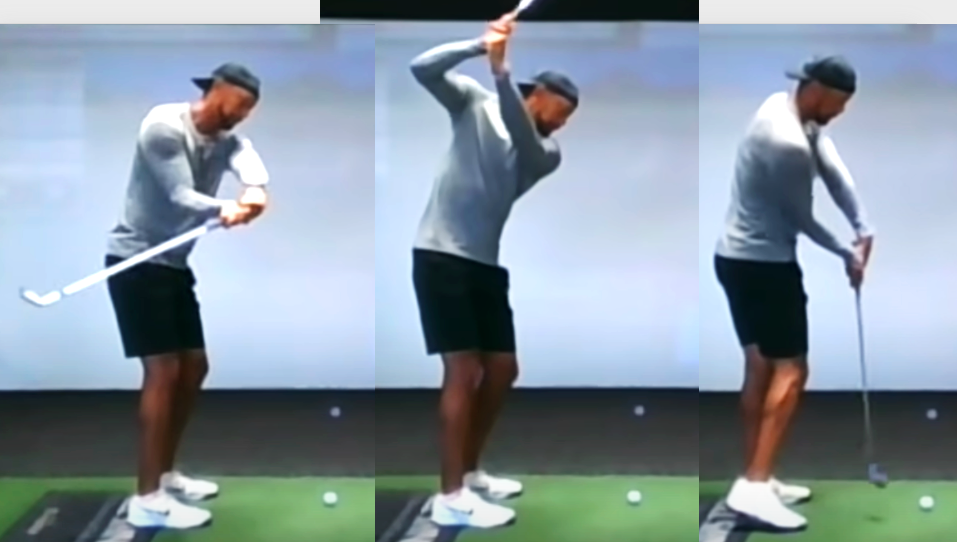
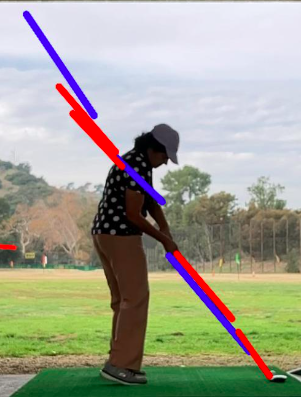
He discusses many ideas to prevent golfers ‘flipping’ through impact. Is he himself flippy (see pictures below)? What is the sign of a flip, i.e. in which direction should the hands be pointed to recognize one? What causes flippiness? Why does it matter and how does it affect ball-flight?

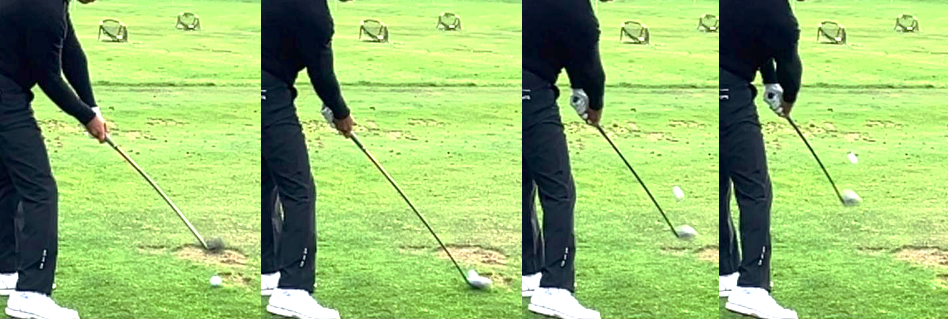
He likes deep hip sockets back and through to create room for any desired shot, and is very big on keeping the butt back in the downswing even though the left hip might extend (in anatomical terms keeping the butt back requires hip flexion so what does he actually mean?) For that matter, is there a fine line between early extension and good verticals through hip extension?
If the butt stays back Tiger believes you have ‘all the room in the world’ to swing left or down the line or push out to the right, whatever shot pattern you want (see pictures below – are they a path change? What about where the face aims at impact?)
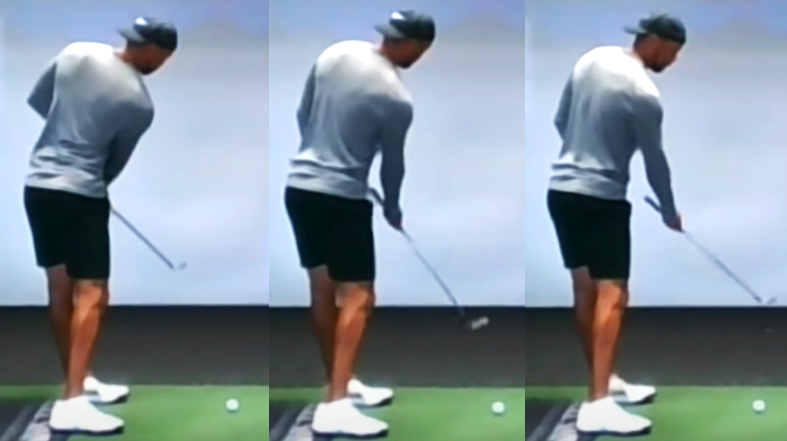
Why does he believe he needs room through ‘butt back’ when his arms throughout his swing are so far away from the body anyway?
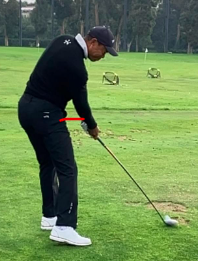
Does he know that the moment of inertia or resistance to movement increases when the arms are further from the body? Also that in industrial settings workers are trained to keep heavy loads closer to the body when lifting them to reduce back pain risk (google the online course ‘Essentials of Sports Injury Prevention & Rehabilitation’ at onlinecourses.nptel.ac.in to learn more). The golf club behaves just like a heavy load as it exerts a lot of force on the golfer – about 115 lb force on the hands alone if he swings a driver at 121 mph, and far more if the mass of other body parts and their distance from the clubhead (radius) need to be factored in (see: https://forums.golfwrx.com/topic/1908925-centripetal-force-pulling-115lb-on-a-200g-clubhead-at-121-mph-swing-implications-biomechanists-physicists-where-u-at-dr-kwon-reply/ )
Tiger’s butt-back incidentally, also causes his spine to have an angle of 60 degrees at the top of his backswing (see picture below).
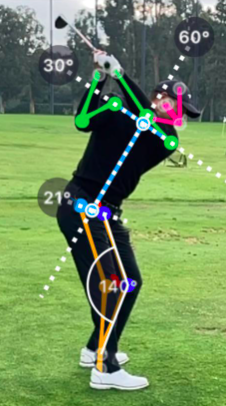
That much forward bend causes large compressive loads on the spine as strong back muscles pull back and down to maintain body position against the pull of gravity. Forward bend is known to be one of the big causes of low back pain and injury.
Moreover, a little-known fact (see this most wonderful paper: https://www.jospt.org/doi/epdf/10.2519/jospt.2010.3025 specifically see end of page 88) is that when the hip joint is in sixty degrees of flexion (forward bend) or more, the main muscles of pelvic external rotation (in simple terms what the trail hip does in the golf downswing) switch their rotation action (to internal rotation). Thus any attempt at trail-side downswing pelvic rotation would become more difficult and presumably lead to more strain on the hip joint and perhaps compensations from the lumbar spine (low back).
The role of the knees, Tiger believes, is to have the left knee behind the ball at the top and then, in the downswing, a golfer should keep the right knee facing the target, not the target line, as the left knee goes back away from the target line to create room. But excessive knee extension of the lead knee (see picture below showing knee extension from top to impact), especially when swinging at speed is known to be injurious to many of the tissues surrounding the lead knee, including the anterior cruciate ligament that Tiger has had surgery from having damaged. A good read about causes of lead knee injury in golf (available as a free pdf file via scholar.google.com” is titled “Biomechanical factors leading to high loading in the anterior cruciate ligament of the lead knee during golf swing”, by Purevsuren et al, 2020)
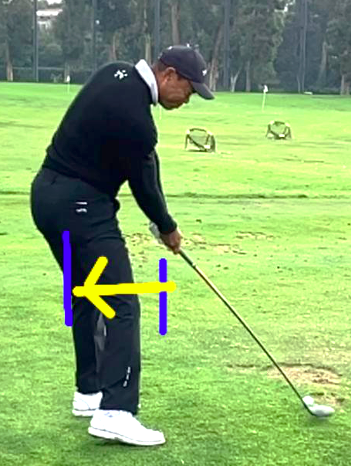
To avoid casting, and prevent OTT, the right shoulder, Tiger believes, should stay back and the arms should fall back. In other words, he would suggest that a golfer keep the right shoulder back and let the club fall vertically, to not be ‘cast-y’. Note that this is not a movement that is easily controlled. The motor control system must find a way to undo all the body movements within the 1/3rd sec. the downswing lasts. That means undoing body rotation, weight shift, body lift, arms lift, trail elbow bend, wrist bend etc. in the simplest manner that it can, typically using some common strategy for everything to happen all-together. So the order will be whatever is easiest from the top in order to do what the motor control system does best – goal-directed delivery of the implement (golf club) to the object of interest (golf ball). It cannot configure an in-to-out path or an angle of approach to get all the movements of the backswing completed in time. That is why both over the top and early extension are so common amongst golfers – it is the default mechanism by which the motor control system can most easily deliver the club to the ground.
Another comment Tiger made was that a wide, deep backswing is good. His could easily be wider and deeper, and, indeed he needs to be. That, however, is not easy with the traditional golf swing, especially as people age. See his pictures below vs what he could be with some swing changes, below that.
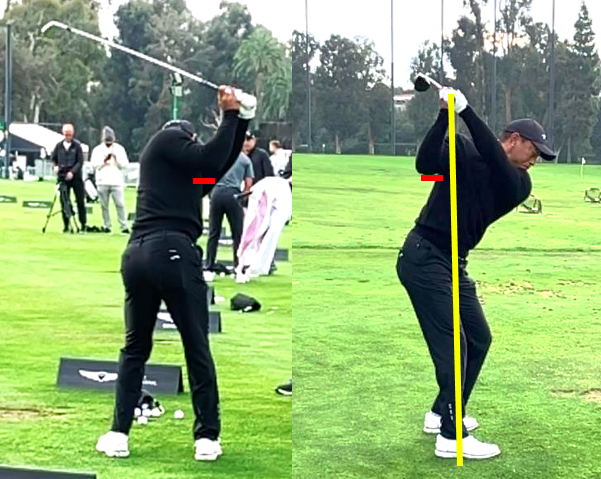
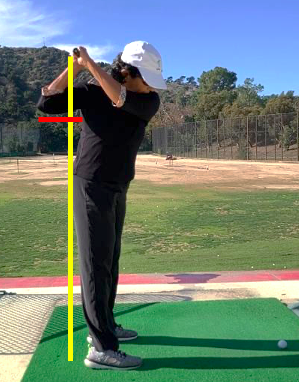
Finally, Tiger encourages practicing in opposites to change behaviors. So if someone has a takeaway that goes in with the shaft, then up and then around, they should do the opposite.
Opposites do not actually or easily change deeply ingrained movement patterns. A new set-up that triggers the desired new motion is a far more effective way of making swing changes. Especially if the swing changes are able to physically prevent the early extension Tiger appears concerned about through an alternate mechanism to the anatomically dangerous ‘butt back’.
Understanding how the athlete performs under pressure
After understanding how Tiger thinks, another important step would be to observe him in competitive conditions. The opportunity to understand how he plays under pressure came from the Play by Play analysis (from: https://www.pgatour.com/tournaments/2024/the-genesis-invitational/R2024007 ) of Tiger’s most recent competitive round at the 2024 Genesis Invitational at Los Angeles’ iconic Riviera Country Club, and it reveals some interesting facts.
Day 1 Directional issues
Hole 1, Par 5, 498 yards, Birdie: Shot 1 to right rough, Shot 2 to right rough
Hole 3, Par 4, 448 yards, Bogey: Shot 1 to right rough
Hole 11, Par 5, 587 yards, Birdie: Shot 2 to left rough
Hole 12, Par 4, 477 yards, Bogey: Shot 1 to right rough
Hole 13, Par 4, 444 yards, Par: Shot 1 to left rough, Shot 2 to left rough
Hole 15, Par 4, 482 yards, Bogey: Shot 1 to left rough
Hole 18, Par 4, 475 yards, Bogey: Shot 2 to right native area
Day 1 Distances hit on Pars 4 and 5
Hole 1, Par 5, 299 yds.
Hole 2, Par 4, 307 yds.
Hole 3, Par 4, 270 yds.
Hole 5, Par 4, 272 yds.
Hole 7, Par 4, 259 yds.
Hole 8, Par 4, 314 yds.
Hole 9, Par 4, 304 yds.
Hole 10, Par 4, 309 yds.
Hole 11, Par 5, 332 yds.
Hole 12, Par 4, 276 yds.
Hole 13, Par 4, 222 yds.
Hole 15, Par 4, 288 yds.
Hole 17, Par 5, 324 yds.
Hole 18, Par 4, 295 yds.
While the club used (driver or other) is not known, what may be seen is that his hitting range with the tee shot varies from 222 yds. to 332 yds. Could both directional and distance spray be reduced with more efficient swing positions and movements? Could such positions and movements have the equally important benefit for him of reducing injury-risk?
The very-unique ANATO-MECHANICAL analysis
What is that, a golfer used to the term ‘biomechanical analysis’ might ask? It involves first of all looking at what the body’s joints and muscles are doing during the swing.
You cannot simply move here or there because traditional swing lore tells you you should. Every movement in the backswing involves some muscles contracting and other stretching to permit the movement. It is important to know which muscles are being stretched in which directions, because only then can one understand how, and in which direction, the body will undo the movement in the downswing.
Here is a good example. Every muscle is made up of fibers. The external oblique in the picture below is a torso muscle with both vertical and horizontal fibers. If your movement stretches the fibers in an upward direction (as in a typical golf backswing), then your body can only drop down. Conversely, if you stretch the more horizontally-directed fibers, it is difficult to be over the top.
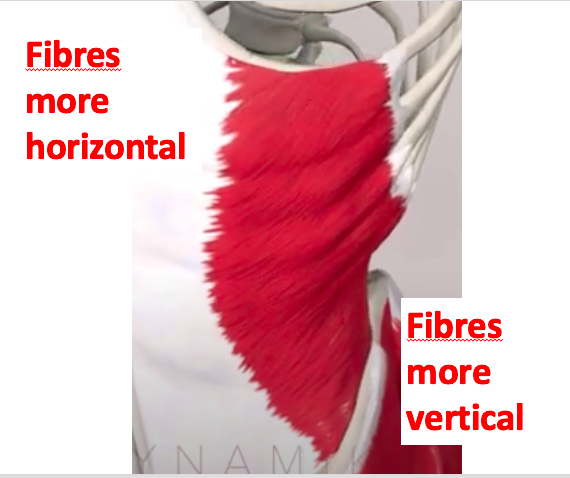
The following are a few big-picture ideas for how the world’s only ANATO-MECHANICAL evaluation is conducted. (angle and line analyses courtesy XView, at xview.ai)
Club shaft plane
Look at his club shaft positions (below) going back and through. Should the shaft positions back and through be simplified as it requires muscle effort (resulting in swing inefficiency and inconsistency) to move the shaft from off plane to on plane? Especially during the fast speed of the downswing?
Art Maffei is a retired rocket scientist (https://www.bodigolf.com/) and has been saying for many years that it is important for the shaft to return to its impact plane (the position where it is at impact) as soon in the downswing as possible, as it is easier to achieve when downswing velocity is lower. Why get off-plane at all, in that case? (A fully on-plain movement in the second picture below).
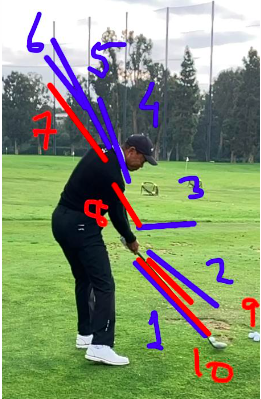

A question golfers need to ask themselves – where should the golf club be at the top in order to bring it back from an inside, shallow path with a square face and at maximum speed with zero compensations? Tiger is still slightly outside the desired shaft plane just before impact (see pictures below).
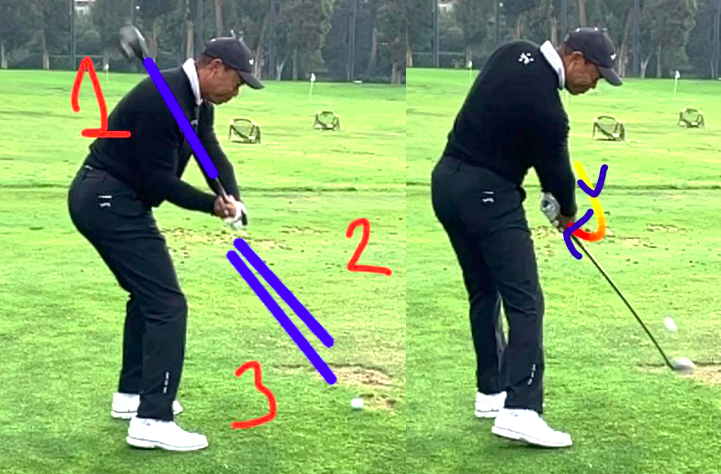
Some might say that the camera angle is not quite correct (which it is not) but it can be seen that many last-minute forearm, wrist and hand manipulations are required to move tiger’s club during the pre-impact to post-impact phase.
And therein lies one of the biggest issues golfers have faced. Using the hands and wrists for last-minute manipulations. They can never be consistent and are not required at all – but that is a subject for another day. In the meantime, look at (pictures below) how much Tiger’s forearm, wrist and hand movements change close to impact. At a time when the trail hand grip pressure is practically zero, and the hands are freewheeling through impact.


Increasing vertical forces – easily
To avoid the complicated butt-back position and increase the vertical forces Tiger so admires, the simplest method is through a deep, wide swing that keeps the shoulders horizontal, not tilted to the ground (see pictures below) rather than the narrow, less deep one he has (also below).

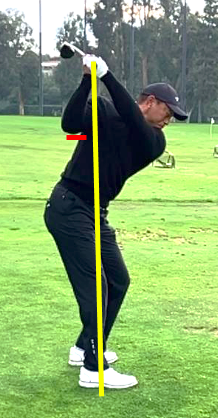
Now the motor control system can easily drop the shaft back and down with no thought and after the body moves downwards, it is naturally pushed up again, without any intentional thoughts by the golfer.
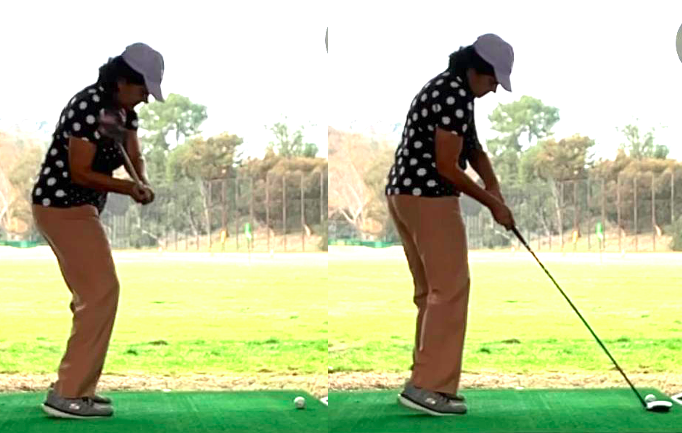
Why? Because one of the mechanisms the motor control system uses is goal-directed motion – as the eyes calibrate the distance of the club head from the arms, the body gets pushed up for correct delivery distance between the lead shoulder joint and the ball.
Increasing rotary forces – easily
And one final big-picture discussion. According to this must-watch video (https://vimeo.com/ondemand/newscienceofgolf) by world famous biomechanist Stuart McGill, “golfers are elastic athletes” and the “muscles are pulsing springs” in those who hit the ball a long way. “It is not about randomly creating more motion in the body but rather about creating a tuned stiffness to more strategically store elastic energy and then recover it upon recoil.” The abdominal muscles (mainly trail side external oblique) burst on at ball impact, preceded by the trail side hip external rotator muscles just prior to impact.
Really then, the golfer just has to be in position for a quick pulse of activation from the core muscles without any need for exaggerated and often injury-causing movements. All that matters, without any great backswing or downswing torso rotation, is to have a slightly closed torso just prior to impact, and thus be able to pull the arms towards the ball through a slightly inside path. It would help all the interconnected muscles of the scapula, the shoulder joint, all associated fascia to deliver the ball from a great path. It is very important to understand that the torso is a heavy, slow-moving part of the body with very limited innervation and cannot make large ranges of movements efficiently.
While this ANATO-MECHANICAL analysis could go on for the second 2500+ words, it will not bore the reader any further. The main takeaway message here is that it is time to re-imagine a science-backed, SIMPLE golf swing as even the very best golfers in the world are inconsistent as well as frequently injured.


